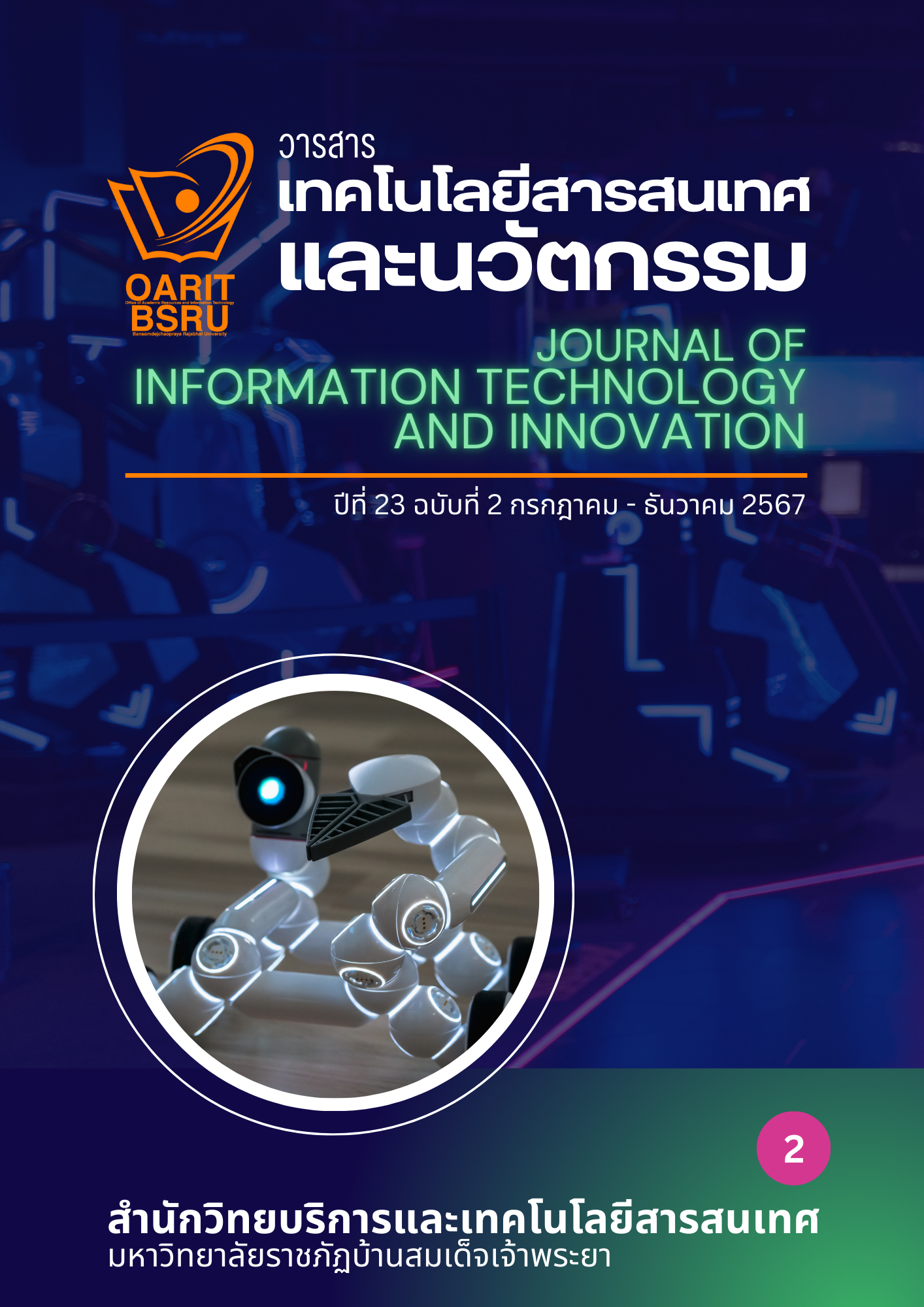Design and Development of Wat Mahathat Worawihan (Royal Temple) Website, Phetchaburi Province
Keywords:
Website development, Wat Mahathat Worawihan, PhetchaburiAbstract
The purposes of this research were 1) to design and develop a website, 2) to evaluate the website's performance by experts, and 3) to assess user satisfaction with the website of Wat Mahathat Worawihan (Royal temple) in Phetchaburi Province. The samples were divided into 2 groups, Group 1 consists of 5 experts in website development, educational technology, information, religion, and culture, selected by purposive sampling and Group 2 used in the study of the website satisfaction: 396 people who were randomly selected. The research tools were the website of Wat Mahathat Worawihan (Royal Monastery) website in Phetchaburi Province, a website efficiency evaluation form, and a user satisfaction evaluation form. Data was collected through online questionnaires. Statistics used for data analysis include frequency distribution, mean, and standard deviation.
The results showed that 1) The website developed using the ADDIE Model's 5-step process successfully met its objectives and is practical. The website design adheres to fundamental principles, comprising three essential components: Website Header, Body Content, and Website Footer, with content proportionally distributed for effective web design. The use of purple and yellow colors, traditional to the temple, and the Prompt font style contribute to a modern, readable, and consistent appearance throughout the site. It supports display across various devices through Responsive Web design. 2) Overall, the website performs at a high level. Efficiency in supporting multiple devices is rated the highest, followed by the content and navigation system. 3) Users express high satisfaction overall, with the website is high level. The highest satisfaction is in the website's usefulness, followed by content presentation and design.
References
กรรณิกา คำดี. (2558). วัดและศาสนสถานในมิติของการท่องเที่ยว. ว.บัณฑิตศึกษา มนุษยศาสตร์และสังคมศาสตร์ มหาวิทยาลัยขอนแก่น. 4(2), 175-191.
ณิชนันทน์ จงใจสิทธิ์. (2560). การออกแบบและพัฒนาเว็บไซต์ประชาสัมพันธ์หมู่บ้านวัฒนธรรมไทดำ บ้านนาป่าหนาด ตำบลเขาแก้วอำเภอเชียงคาน จังหวัดเลย. ว.มนุษยศาสตร์และสังคมศาสตร์ มหาวิทยาลัยมหาสารคาม. 36(3), 33-47.
นิรันดร เลิศวีรพล. (2562). คู่มือการสร้างและพัฒนาเว็บไซต์ของมหาวิทยาลัยมหาจุฬาลงกรณราชวิทยาลัย วิทยาเขตขอนแก่น. มหาวิทยาลัยมหาจุฬาลงกรณราชวิทยาลัย วิทยาเขตขอนแก่น.
บางกอกอินไซท์. (2563). เที่ยวเพชรบุรีดีงาม ศิลปวัฒนธรรมประทับใจจำไม่รู้ลืม. https://today.line.me/ th/v2/article/D6jKpp
บุญชม ศรีสะอาด. (2545). การวิจัยเบื้องต้น (พิมพ์ครั้งที่ 7). สุวีริยาสาส์น.
พระสนั่น เจริญยิ่ง. (2565). รูปแบบการท่องเที่ยวเชิงพระพุทธศาสนาของวัดไร่ขิง [วิทยานิพนธ์ศิลปศาสตรมหาบัณฑิต, มหาวิทยาลัยศิลปากร].
มหาวิทยาลัยราชภัฏนครปฐม สำนักคอมพิวเตอร์. (2565). เอกสารประกอบการอบรม เรื่อง หลักการออกแบบเว็บไซต์ที่ดี. ผู้แต่ง.
มหาวิทยาลัยราชภัฏเพชรบุรี สำนักวิทยบริการและเทคโนโลยีสารสนเทศ. (2558). วัดมหาธาตุวรวิหาร จังหวัดเพชรบุรี. https://shorturl.asia/CXDVx
วรินทร ซอกหอม และนครินทร์ ชัยแก้ว. (2564). การพัฒนาเว็บไซต์คณะเทคโนโลยีสารสนเทศและการสื่อสาร มหาวิทยาลัยพะเยา. ว.Mahidol R2R e-Journal. 8(1), 117-128.
สมบัติ ท้ายเรือคำ. (2553). ระเบียบวิธีวิจัยสำหรับมนุษยศาสตร์และสังคมศาสตร์ (พิมพ์ครั้งที่ 4). โรงพิมพ์มหาวิทยาลัยมหาสารคาม.
สุจิตรา ด้วงทอง. (2564). ปัจจัยที่มีผลต่อความพึงพอใจของผู้ใช้บริการเว็บไซต์คณะศิลปศาสตร์ มหาวิทยาลัยเทคโนโลยีราชมงคลธัญบุรี. ว.การพัฒนางานประจำสู่งานวิจัย. 8(2), 25-35.
สำนักงานรัฐบาลอิเล็กทรอนิกส์ (องค์การมหาชน). (2564). มาตรฐานเว็บไซต์ภาครัฐ เวอร์ชัน 2.0. https://shorturl.asia/LbC3j
Bader, W., & Hammouri, A. (2016). Responsive web design techniques. International Journal of Computer Applications. 150(2), 18-27.
Bhanarkar, N., Paul, A., & Mehta, A. (2023). Responsive web design and its impact on user experience. International Journal of Advanced Research in Science. Communication and Technology (IJARSCT). 3(4), 50-55.
Savani, N. (2023). The future of web development: An in-depth analysis of micro-frontend approaches. International Journal of Computer Trends and Technology. 71(11), 65-69.
Seels, B., & Glasgow, Z. (1998). Making Instructional Design Decisions (2nd ed.). Prentice Hall.
Yellow. (2023). Web Development Trends in 2023. Author.
Downloads
Published
How to Cite
Issue
Section
License
Copyright (c) 2024 Journal of Information Technology and Innovation

This work is licensed under a Creative Commons Attribution-NonCommercial-NoDerivatives 4.0 International License.
บทความ ข้อความ ภาพประกอบ และตารางประกอบที่ลงพิมพ์ในวารสารเป็นความคิดเห็นส่วนตัวของผู้นิพนธ์ กองบรรณาธิการไม่จำเป็นต้องเห็นตามเสมอไป และไม่มีส่วนรับผิดชอบใดๆ ถือเป็นความรับผิดชอบของผู้นิพนธ์เพียงผู้เดียว






